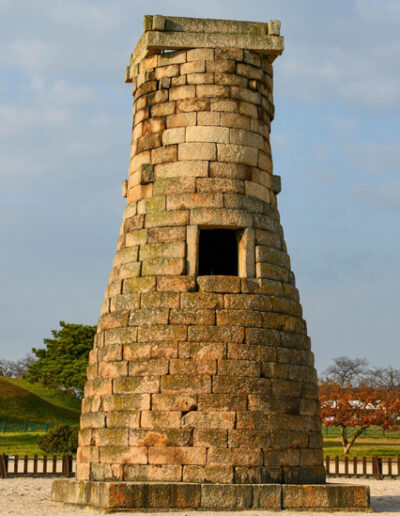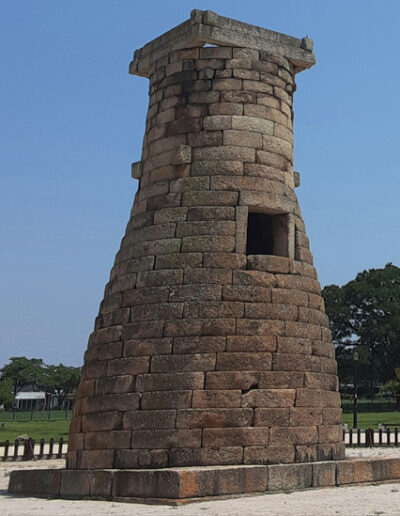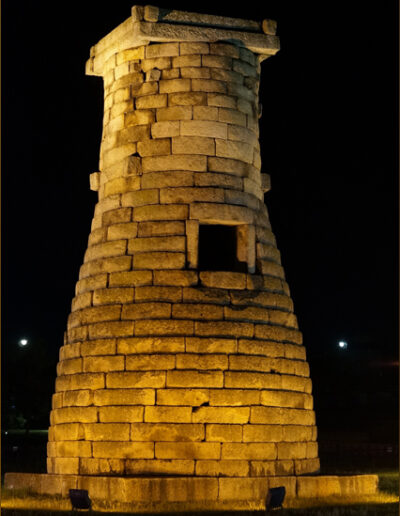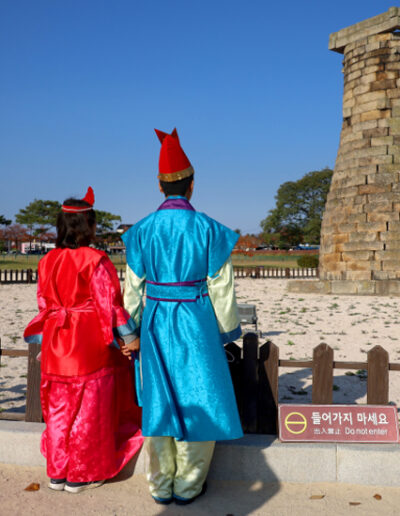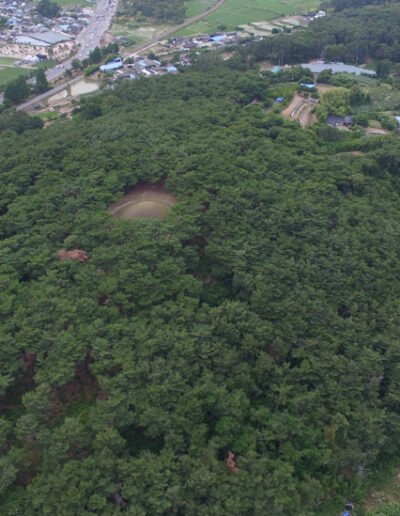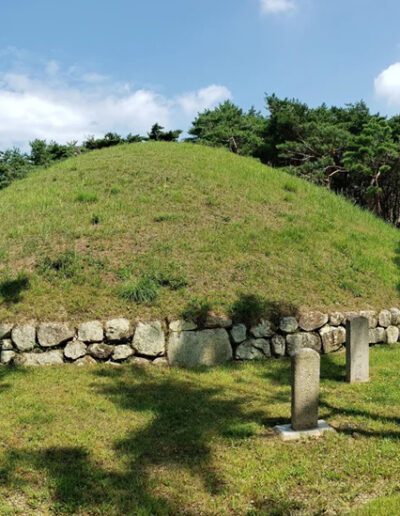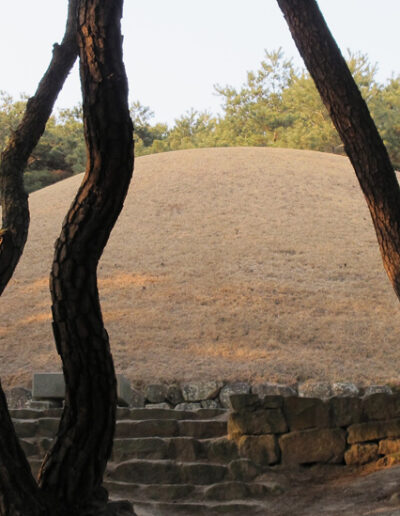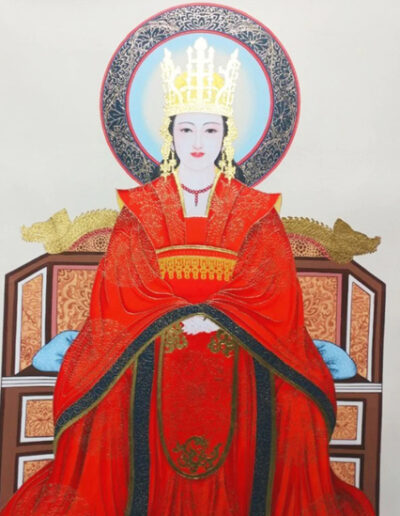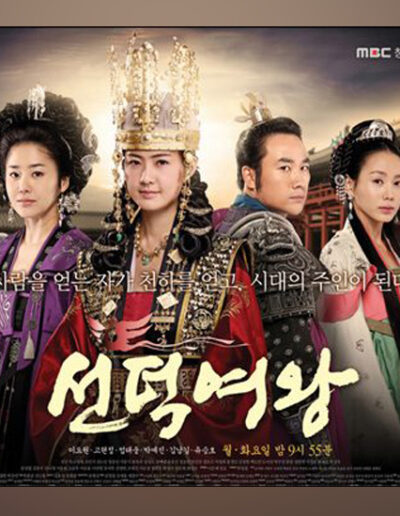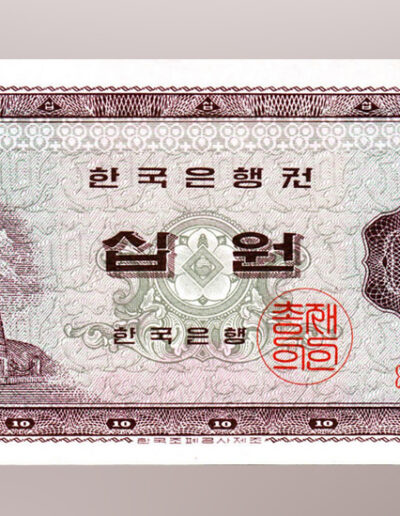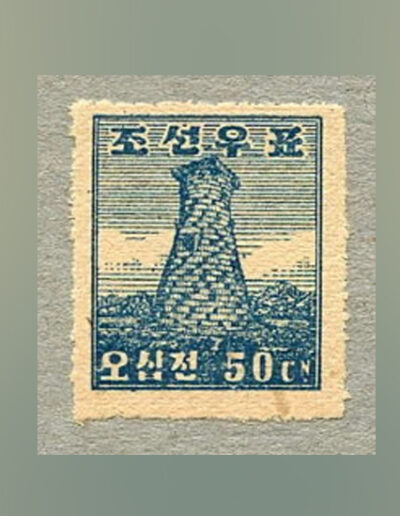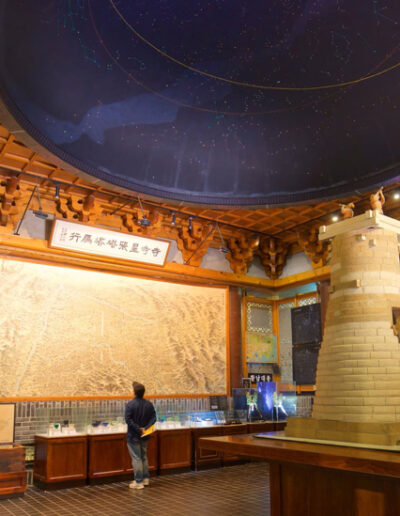Cheomseongdae
633 CE
About the Object
Story of the Object
Teaching suggestions
Classroom Extras
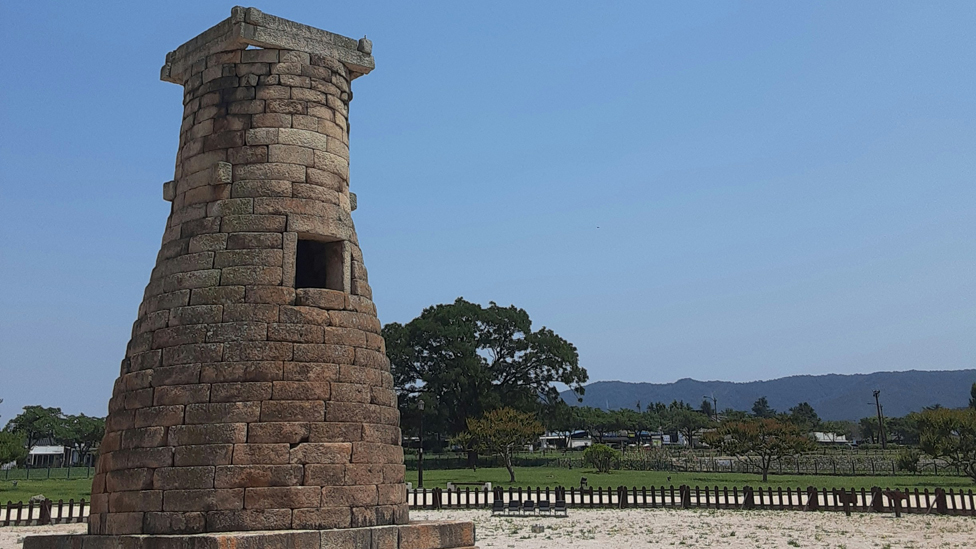
Cheomseongdae
Cheomseongdae translates from the Korean as ‘star gazing tower’.
It is the oldest surviving astronomical observatoryAn observatory is a place used for watching events on land, in the sea or in the sky. An astronomical observatory watches what is happening in the sky. in the world.
The tower is one of the great treasures of the 1,000-year-old kingdom of Silla.
It is situated in Gyeongju and was built in 633 during the reign of Queen Seondeok of Silla, who ruled from 632-647.
In 1962 it became the 31st National Treasure of Korea and is now part of the UNESCO World Heritage Site which includes the Gyeongju historic areas.
It appears that it might have been part of a wider scientific area in Gyeongju and it was built to help farmers.
Such was the importance of the observatory that it influenced the construction of the Senseidai observatory in Japan in 675 and the Duke Zhou’s observatory in China in 723.
This observatory demonstrates not only the astronomical fascination of the Korean people with the stars and planets but also the advanced scientific knowledge and skill of Korean scientists and astronomers.
Cheomseongdae is also a visible display of the drive, influence and power of Queen Seondeok herself.
The history of the observatory
During the 7th century the Kingdom of Silla was approaching the height of its prosperity and power.
By 668 it had managed to conquer the Kingdoms of Baekje and Goguryeo which brought to an end the period the Three Kingdoms.
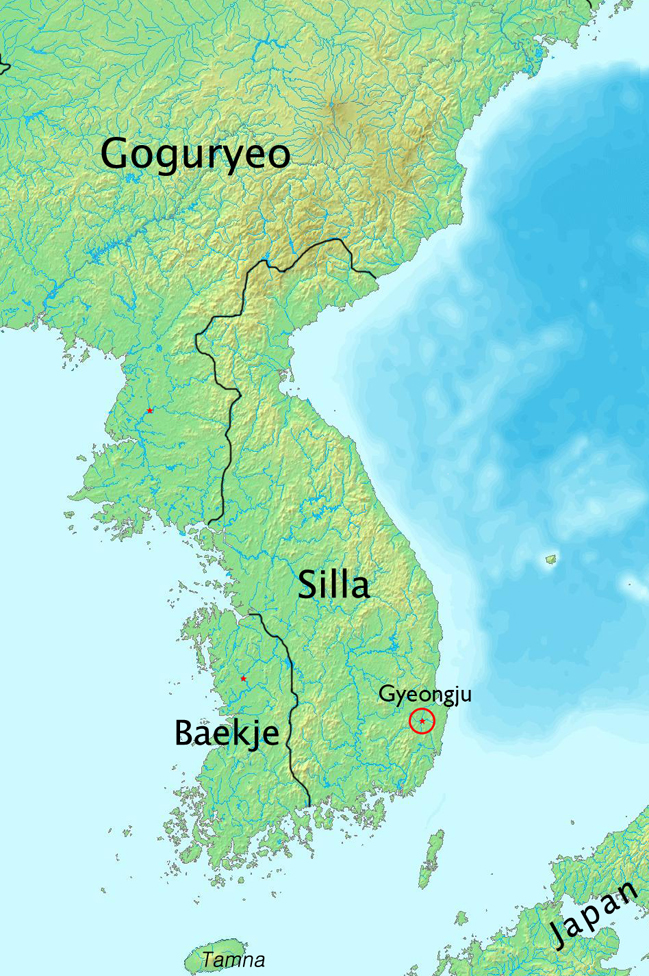
Map of Korea in the 7th Century CE showing the location of Gyeongju
This success enabled the rulers of Silla to unify the central and southern regions and control the whole of the Korean peninsula.
The capital of Silla was Gyeongju and it became a centre of culture.
It was known in Europe as a result of traders who used the Silk Road, a network of trade routes that linked China with Europe.
The arts flourished and some of the best preserved ancient Korean literature was written at this time.
There was also great interest in sciences with mathematics, astronomy and astrology.
This is because Korean culture was fascinated by how the planets and stars interacted and the impact on Earth of what happened in the skies.
On becoming Queen in 632, Seondeok was focused on improving the lives of her people and doing what she could to help everyone.
As a result, Cheomseongdae was built in an attempt to help farmers.
The observatory allowed astronomers to monitor the movement of the stars, determine time and calculate the changes in the seasons of the year.
For any farming based society, it was important to know about the seasons and when they were changing.
Cheomseongdae helped farmers to know when to plant and harvest their crops so they could provide sufficient food to feed the people.
The observatory tower
The tower of the observatory is symmetrical and consists of three parts:
- a base (known as a stylobate), upon which a column is built,
- a curved cylindrical body resembling a bottle, and
- a square top.
It is 9.17m high, which is the equivalent of two double decker buses, one on top of the other.
The square stylobate base is 5.7m wide and built from a single layer of 12 rectangular stones.
Halfway up the cylindrical tower is a square window which was the entrance to the inside of the structure.
In all there are 27 courses of bricks – 12 up to the halfway window, 3 for the window and 12 above the window to the top.
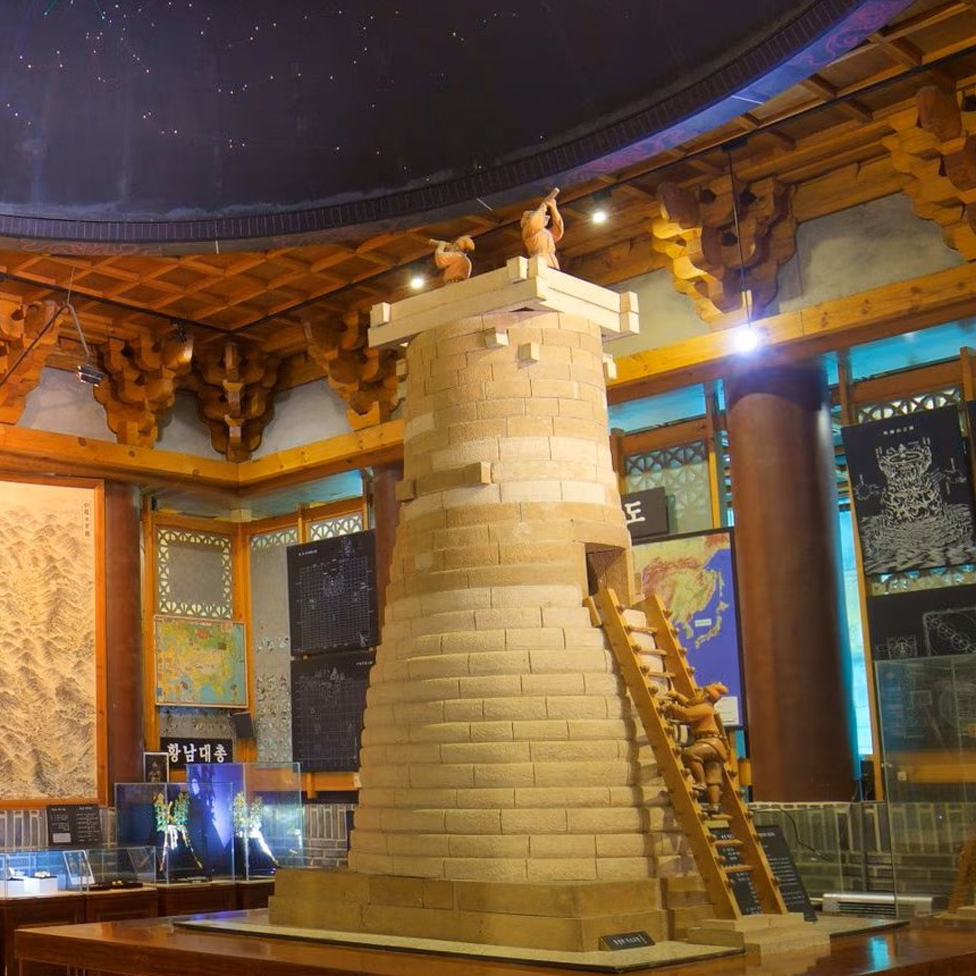
Detail of a view of a model of the Cheomseongdae Tower in the Silla Arts and Science Museum Gyeongju showing astronomers (a) climbing a ladder to enter the tower and (b) on top of the tower using astronomical instruments
The location of the window exactly halfway up is significant because it is south-facing and captures the sun’s rays on the interior floor on the spring and autumn equinoxes.
It is generally accepted that the cylindrical body of the tower is built out of 365 pieces of cut granite.
The stones are fashioned as annular sectors, meaning each stone takes the shape of a curved or bent rectangle.
The tower narrows as it rises and is topped by a square frame made from eight long blocks, two on each side, known as Jeongja-seok.
Unfortunately, the instruments used for observation, and observatory records, have not survived.
As a result, the exact methods of taking observations are not known.
However, surviving records do imply that astronomers used a ladder placed against the side of the tower to gain access through the window.
A ladder or ladders inside the tower would then allow astronomers to climb to the top and use their instruments to observer the sky.
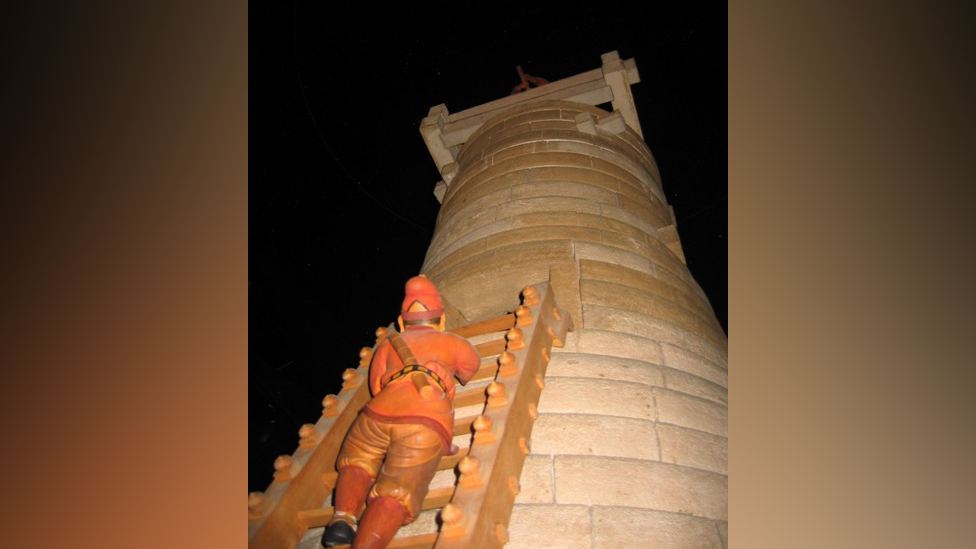
A scaled down model of Cheomseongdae showing its use as an observatory, Silla Arts and Science Museum, Gyeongju
Building the tower
In an age without modern equipment and in a time in history when construction techniques were not fully documented, it is important to consider how the observatory might have been built and why it was built in that particular way.
Experts now believe that increasing amounts of earth were pushed into a mound around the base allowing the granite blocks to be positioned and fixed in place.
As the tower was built, more earth was brought in allowing more granite blocks to be moved into place.
Once the tower was built, the earth was removed to reveal the bottle shape of the tower.
However, the earth was not removed from inside the tower below the window and the space for the base to the window is filled with stones and earth.
This central core of rubble has helped to reinforce the tower and ensure its stability.
It also prevented flooding because any rainwater which would enter the tower through the hole in the roof could soak away.
In addition, investigations have shown that the tower was built on rock and stone foundations.
It is believed that this was not just to help make the tower stable, but also to protect the tower in case of earthquakes.
In 2016 an earthquake measuring 5.8 hit the Gyeongju area but the tower survived intact and undamaged.
Investigation of Korean historical records reveals that there have been earthquakes of even greater magnitude in the past.
It would be fair to assume that such was the advanced nature of Korean scientific knowledge, 7th Century engineers in Korea appreciated the dangers of earthquakes and had the tower built to withstand possible damage.
Symbolism of the tower’s construction.
| The construction of the observatory | What this represents |
| 29 layers of stone in all | 29 days in a lunar month |
| 27 layers of stone comprising the cylindrical shape – that is 29 layers excluding the square stylobate at the bottom and the square Jeongja-seok frame at the top | 27 days in the moon’s orbital period and Queen Seondeok was the 27th ruler of Silla |
| 12 layers of stone below the window and 12 above | 12 months in the year |
| 24 layers of stone either side of the window | According to the cultures of several countries of the Far East including Korea, each of the four seasons has six sub-divisions referred to as solar terms. As a result, there are 24 seasonal divisions. These sub-divisions refer to specific changes in nature and the weather and so enable farmers to be much more precise in the activities they undertake. |
| 365 stones | 365 days in a year |
What is important here is that Korean engineers carefully planned how the tower was to be built so that when completed it would enable astronomers to understand the sky and be able to assist farmers in their work.
It is a testament to early Korean engineering and to the advanced nature of Korean scientific and mathematical knowledge.
At this time, people believed that a monarch’s power was divine and emanated from the stars in the sky.
As a result, the tower was immensely symbolic meeting both the needs of the farmers and of the monarch, in this case Queen Seondeok.
Queen Seondeok of Silla – early life
Queen Seondeok, born between 580 and 610, was the first woman to rule in her own right as queen of Silla, and the first female monarch in Korean history.
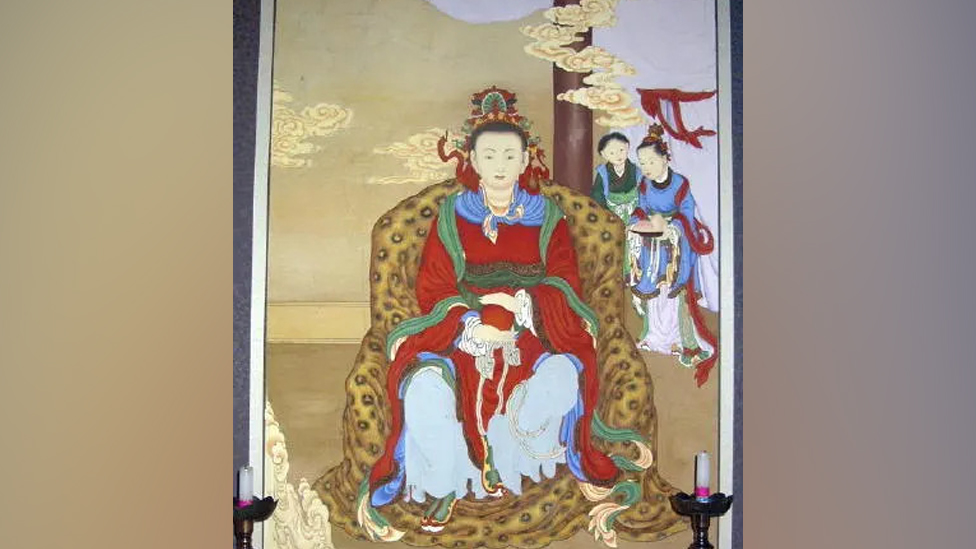
A painting that is believed to be Queen Seondeok painted by a monk. It was found in a temple in Jeju Island which is called Seon Deok Sa located in Halla San’s eastern slope.
As there had never been a female ruler in Korea, there was opposition to the idea of a woman succeeding to the throne.
Seondeok, however, was described as being “generous, benevolent, wise, and smart”.
Hwang, Kyung Moon (2016). A history of Korea : an episodic narrative (2nd ed.). London. P20. ISBN 9781137573568. OCLC 96317395
As quoted in Wikipedia
It was these characteristics that appear to have convinced her father, King Jinpyeong, who had no male heirs, and in turn his advisers and the leading nobles, that she would be a suitable leader.
Queen Seondeok of Silla – as queen
On becoming queen, she set out to prove to everyone, and especially those who doubted her capability, that she was up to the role.
During her reign she had to face dangers at home and abroad. It began and ended with uprisings against the idea of female rule and both revolts were defeated with the leaders captured and punished.
She also had to contend with threats from the neighbouring kingdoms of Baekje and Goguryeo. To help counter these dangers she strengthened diplomatic ties with the Tang Dynasty in China.
In her 14 years as queen, she successfully defended her kingdom. This again enhanced her reputation as a capable ruler and showed to a male-dominated society that women could rule effectively.
Her primary concern was to enhance the lives of her people. She sent royal inspectors across the kingdom to improve the care of widows, orphans, the poor and the elderly.
She allowed peasants to pay no tax for a whole year and reduced the tax for the middle class. These actions helped her earn her people’s support and strengthen her position as queen.
Seondeok strengthened cultural ties with China and encouraged students and scholars to study in this important country.
Through her patronage she brought about a renaissance in thought, literature, and the arts.
Seondeok was a believer in Buddhism, which did not regard women as inferior, and during her reign temples and pagodas were built and statues of Buddha erected.
One of the most famous temples that was built during her reign was the temple of Hwangnyongsa.
According to records, the pagoda was at least 68m (possibly 80m) high, making it one of the tallest structures in East Asia at that time.
Science, mathematics, engineering, astronomy and astrology also flourished, not least because Seondeok herself was fascinated by astronomy.
Queen Seondeok of Silla – the astronomer princess
Seondeok has been called the ‘astronomer princess’ and it appears that it was her interest in astronomy, and her desire to help farmers better understand the seasons of the year, that led to the construction of Cheomseongdae astronomical observatory.
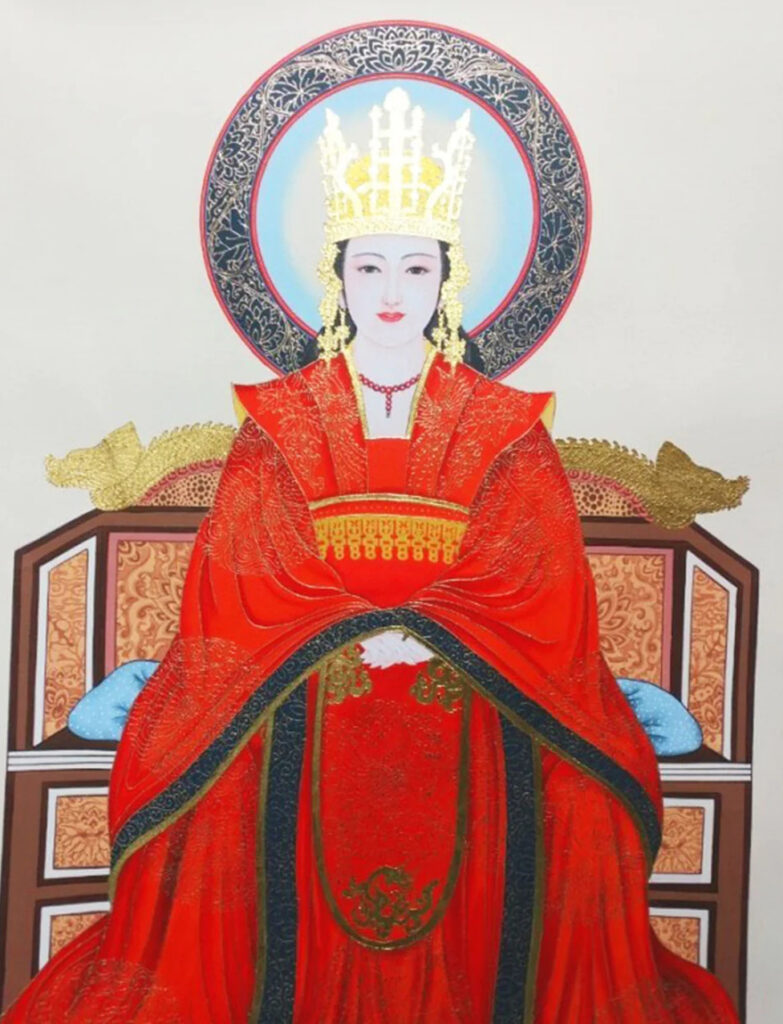
Image of Queen Seondeok, unknown date
Many stories are told about her. They are most likely legends as we cannot be sure as to which parts are fact and which are fiction.
Nevertheless, they do help us understand how she was perceived at the time. She was viewed as a young lady who had a keen analytic eye, had strong opinions, and was confident to display her intelligence.
The stories also show her interest in science and astronomy and help explain why she built Cheomseongdae.
One story about her recounts that, by the time she was 15, she had become fascinated by astronomy.
It is said that she tried to discuss it with her tutor, the Chinese ambassador, who was also an astronomer. He was outraged because he did not consider that astronomy was a subject which a young girl should study.
He was also a strict follower of Confucianism which favoured strict gender roles and believed that a woman’s obligation was to her husband and that her duty was to care for the family and undertake household tasks.
As a result, formal education for women was not seen as necessary and the ambassador, as Seongdeok’s tutor, believed that it was totally inappropriate to have discussions with her which involved such topics as astronomy.
The situation was made worse in that Seondeok went on to accurately predict a forthcoming solar eclipse, both the timing of the event and its duration.
This annoyed the ambassador so much that he is alleged to have said, “Astronomy is not for women. Do anything feminine, such as care for silkworms”. He then proceeded to tell her father who banned astronomy from her studies.
Seondeok felt frustrated and in response she is said to have written the following lines on a votive jar. A votive jar is a jar which usually contains a candle and is dedicated to the memory of someone. It said:
“Will I ever know the truth about the stars?
I’m too young to engage in theories about our Universe.
I just know that I want to understand more. I want to know all
I can. Why should it be forbidden?”
It is clear that, despite her disappointment at being blocked in her studies, her love of astronomy did not disappear.
Within her first two years of becoming queen, she built the Cheomseongdae observatory, which was to play a key role in the life of her people throughout her reign and beyond.
Importance of the observatory
The Cheomseongdae astronomical observatory was a major step forward.
It gave farmers confidence in their work and helped make astronomy an important science.
By studying the skies and the movement of stars and planets, astronomers were able to be more confident in the timings of the seasons year on year.
As a result, they could more accurately advise farmers as to the best time to undertake specific agricultural activities such as planting seeds and harvesting crops.
The observatory also raised the status of astronomy as an academic subject and showed Korean scientific knowledge and expertise to be of a high order.
The astronomers also strengthened the power of Queen Seondeok because it was believed that her authority came from the stars.
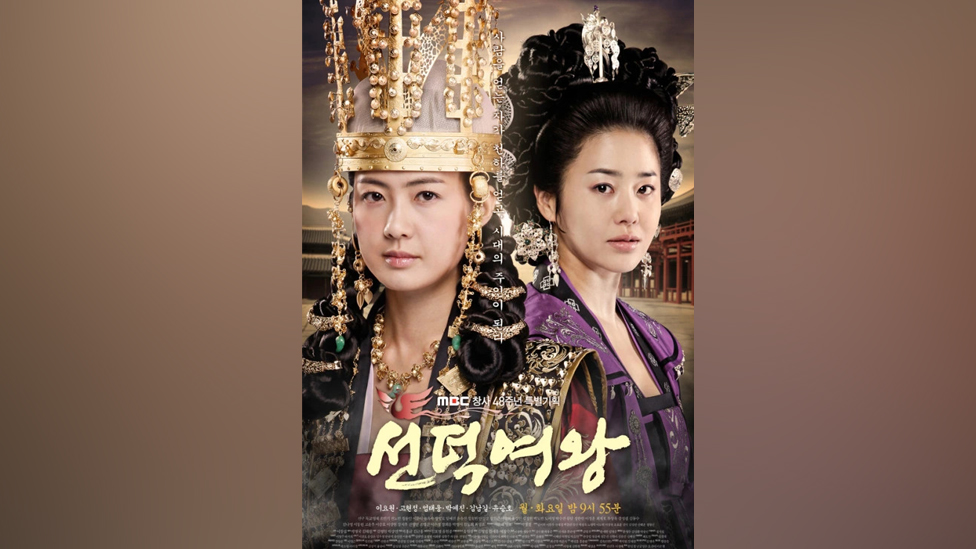
Promotional poster for the TV series Queen Seondeok
Seondeok could rightly be referred to as the “astronomer princess”. She displayed from an early age that she had a fascination with the stars and a skill for scientific deduction and prediction.
Though the observation tower does not mark the beginning of Korean astronomy and astrology, it represents an important landmark in Korean history in the story of understanding the stars.
The story of Queen Seondeok is a classic example of a young lady who persevered with her studies in the face of discriminatory opposition. She defied the odds by ruling as Korea’s first queen, helped her people, and created a lasting legacy through the construction of an observatory which is now the oldest surviving of its type in the world.
Such was the importance of the observatory that it influenced the construction of the Senseidai observatory in Japan in 675 and the Duke Zhou’s observatory in China in 723.
Korea led the world and Cheomseongdae is a visible display of the drive, influence and power of Queen Seondeok herself.
She is undoubtedly an individual whose story and achievements deserve much greater attention beyond Korea than they have traditionally received.
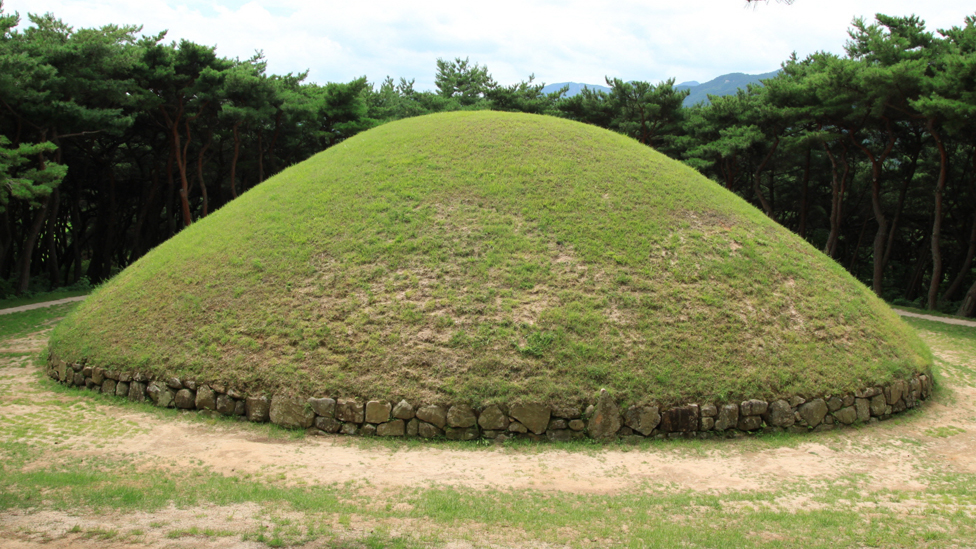
Tomb of Queen Seondeok, Gyeongju © Korea Heritage Service
Retrieval practice
1. The Cheomseongdae astronomical observatory was built during the reign of which monarch?
a) Queen Seondeok of Silla
b) King Jinji of Silla
c) Jinheung the Great
2. Cheomseongdae was designated Korea’s 31st national treasure in what year?
a) 1852
b) 1962
c) 1988
3. In what century was the observatory built?
a) Seventh
b) Eighth
c) Nineth
Observatories around the world
Ask students to research the other early observatories from around the world. This could be an individual or group project.
Two other early observatories are mentioned on the website – the Senseidai observatory in Japan (675) and the Duke Zhou’s observatory in China (723), for example.
Students could create fact files on these – or look for others around the world.
They could even take it up to modern times – for example, the Keck Observatory (Hawaii) can see farther into space than the famous Hubble Telescope.
Write an online encyclopaedia entry for the The Cheomseongdae astronomical observatory
The Cheomseongdae astronomical observatory is clearly a very significant building.
Therefore, why not ask your pupils to research and write an online encyclopaedia entry for the observatory?
It is a good idea to structure their research and give them a specific word count to limit how much they can write. This adds challenge.
Pupils could work individually, in pairs or in groups. You could use these headings to structure their research and then help them to write their entries:
- Brief overview
- The structure (how it was built)
- Symbolism
- How it was used
- Significance today
Where else in the world?
The Cheomseongdae astronomical observatory was built in the 7th Century (probably in 633) during the reign of Queen Seondeok of Silla, who ruled from 632-647.
Ask pupils to research important who people lived at this time, or what other important events or developments took place.
This could have a Korean focus or it could be expanded to give a global perspective.
You might want to widen the period of study to the whole of the 7th Century.
For example, at this time, the Arabian Peninsula is united under the central authority of Abu Bakr – and this is the time of the great expansion of the Islamic Empire.
In England, the 7th Century is a time of great battles between rival kingdoms during Anglo-Saxon times.
Write an obituary for Queen Seondeok of Silla
The Cheomseongdae astronomical observatory was built during the reign of Queen Seondeok of Silla.
It was very unusual in the 7th Century for a woman to rule the Kingdom of Silla.
Queen Seondeok was a significant figure during this period of history and continues to be today.
Interestingly, Queen Seondeok was the focus of a 2009 Korean drama entitled Queen Seondeok.
Ask you pupils to investigate her life and then as write an obituary for her.
Pupils could focus their research on:
- Seondeok’s early life
- Why Seondeok became Queen?
- Threats Queen Seondeok faced from abroad
- Achievements improving life in Silla
- Why was the observatory built?
Write a plaque for the Cheomseongdae Astronomical Observatory
Ask your pupils to write a plaque for the replica in the Cheomseongdae astronomical observatory.
They could work individually, in pairs or in groups.
You could support them by giving them to following headings to find out about:
- When was it built?
- Why was it built?
- Who decided to have it built?
- Uses of the observatory
- Why is it significant?
After they have completed their research explain to them that they need to write a plaque for the observatory.
Give them a word limit of 40 to 50 words. This makes the task much more difficult as they will have to choose their words carefully.
Classroom Extras
Here you will find a number of images, video clips and website links which can be used as extras for teaching in the classroom or for use by pupils undertaking independent research.
Images
Royal Tomb of Queen Seondeok in Gyeongju © Cultural Heritage Administration of the Republic of Korea
Map
Select Google Maps options to view key locations for different objects:
Videos
Watch these films about Cheomseongdae:

Discover more online
Wikipedia: Cheomseongdae
New World Encyclopaedia: Cheomseongdae
UNESCO: Portal to the Heritage of Astronomy Category of Astronomical Heritage
Wikipedia: Queen Seondeok of Silla
World History: Queen Seondeok of Silla
Cosmos: Gabriella Bernardi, The unforgotten sisters: Sonduk, the astronomer queen (Cosmos, 2018)
Wikipedia: Korean culture and the seasons
Seoul Metropolitan Government: Korean culture and the seasons
Teaching Korea is not responsible for the content of external websites
Share to Google Classroom

